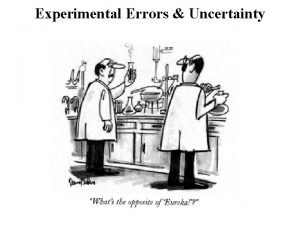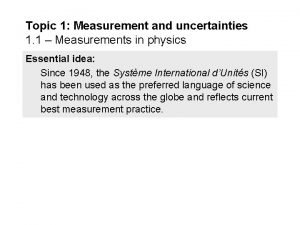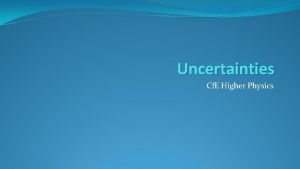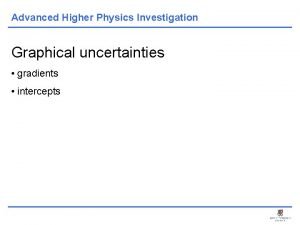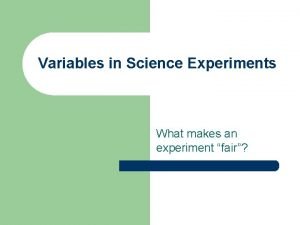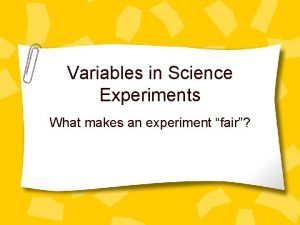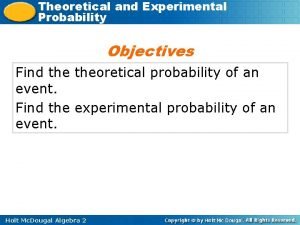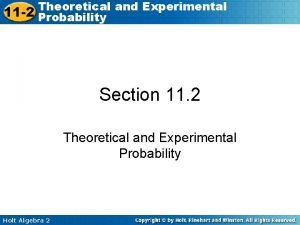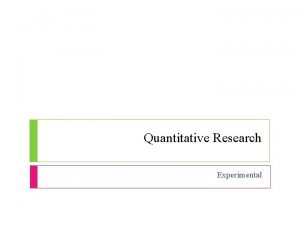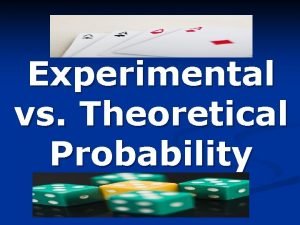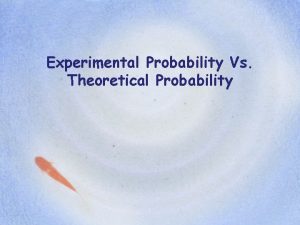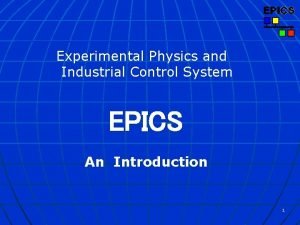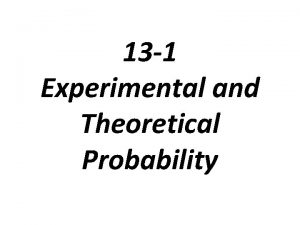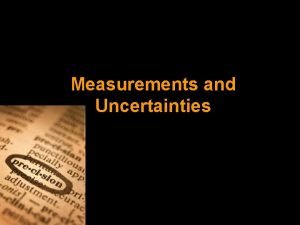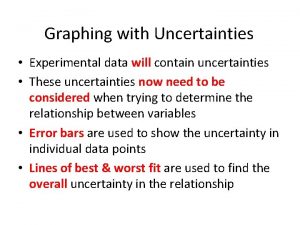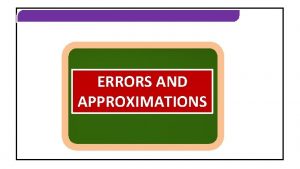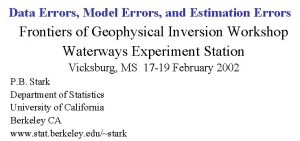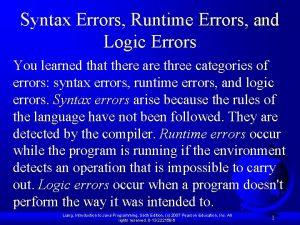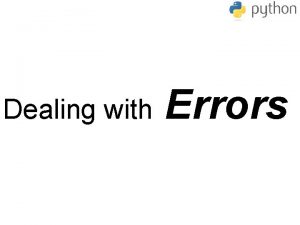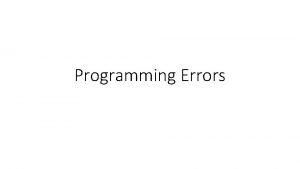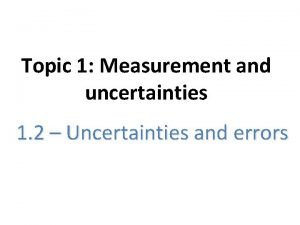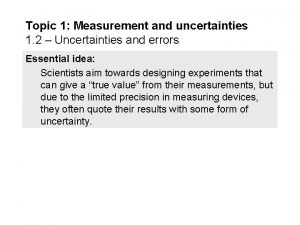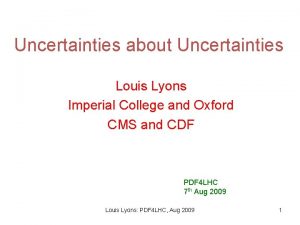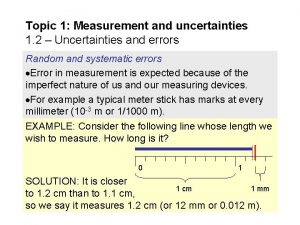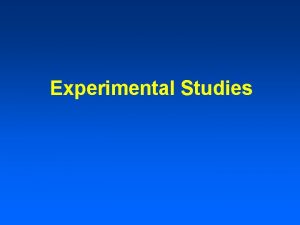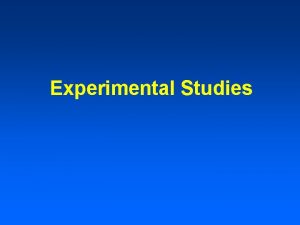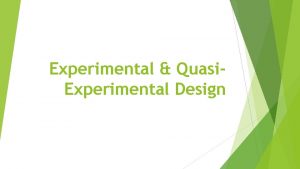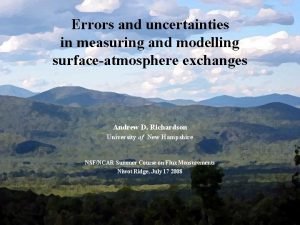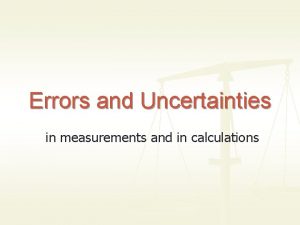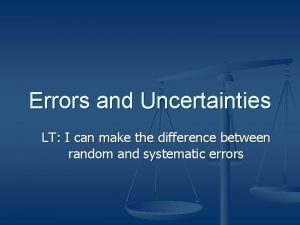Experimental Errors and Uncertainties Errors and Uncertainties n



















- Slides: 19

Experimental Errors and Uncertainties

Errors and Uncertainties n Errors can be divided into 2 main classes n Random errors n Systematic errors

Mistakes n n Mistakes on the part of an individual such as n misreading scales n poor arithmetic and computational skills n wrongly transferring raw data to the final report n using the wrong theory and equations These are sources of error but are not considered as an experimental error

Systematic Errors n n Cause a random set of measurements to be spread about a value rather than being spread about the accepted value It is a system or instrument error

Systematic Errors result from Badly made instruments Poorly calibrated instruments An instrument having a zero error, a form of calibration Poorly timed actions Instrument parallax error Note that systematic errors are not reduced by multiple readings

Systematic Errors n Two types of systematic error can occur with instruments having a linear response: n Offset or zero setting error in which the instrument does not read zero when the quantity to be measured is zero. n Multiplier or scale factor error in which the instrument consistently reads changes in the quantity to be measured greater or less than the actual changes.

Systematic Errors Examples of systematic errors caused by the wrong use of instruments are: errors in measurements of temperature due to poor thermal contact between thermometer and the substance whose temperature is to be found, errors in measurements of solar radiation because trees or buildings shade the radiometer.

Random Errors n n Are due to variations in performance of the instrument and the operator Even when systematic errors have been allowed for, there exists error.

Random Errors result from n n n Vibrations and air convection Misreading Variation in thickness of surface being measured Using less sensitive instrument when a more sensitive instrument is available Human parallax error

Reducing Random Errors Random errors can be reduced by n taking multiple readings, and n eliminating obviously erroneous result or n by averaging the range of results.

Example of a random error n You measure the mass of a ring three times using the same balance and get slightly different values: 17. 46 g, 17. 42 g, 17. 44 g

Practice Problem Which of the following procedures would lead to systematic errors, and which would produce random errors? (a) Using a 1 -quart milk carton to measure 1 liter samples of milk. (b) Using a balance that is sensitive to ± 0. 1 gram to obtain 250 milligrams of vitamin C. (c) Using a 100 -milliliter graduated cylinder to measure 2. 5 milliliters of solution.

Answer n n Procedure (a) would result in a systematic error. The volume would always be too small because a quart is slightly smaller than a liter. Procedures (b) and (c) would lead to random errors because the equipment used to make the measurements is not sensitive enough.

Precision n n Precision is how close the measured values are to each other. A precise experiment has a low random error

Accuracy n n n Accuracy is how close a measured value is to the actual (true) value. An accurate experiment has a low systematic error. Accuracy tells us something about the quality or correctness of the result.

Examples of Precision and Accuracy: Low Accuracy High Precision High Accuracy Low Precision

High Accuracy High Precision n So, if you are playing soccer and you always hit the left goal post instead of scoring, then you are not accurate, but you are precise!

Limit of Reading and Uncertainty The Limit of Reading of a measurement is equal to the smallest graduation of the scale of an instrument The Degree of Uncertainty of a measurement is equal to half the limit of reading e. g. If the limit of reading is 0. 1 cm then the uncertainty range is 0. 05 cm This is the absolute uncertainty or absolute error.

Example n The measurement is taken below using a ruler. The limit of reading is 0. 05 cm and the uncertainty is ½ of the limit of reading, or ± 0. 025 cm. Since uncertainties are only given to one significant figure, the length is stated as 0. 44 ± 0. 02 cm.
 Experimental error definition
Experimental error definition Experimental vs non experimental
Experimental vs non experimental What is quasi experimental research
What is quasi experimental research Experimental vs non experimental research
Experimental vs non experimental research Experimental vs nonexperimental
Experimental vs nonexperimental Experimental vs non experimental
Experimental vs non experimental Absolute uncertainty multiplication
Absolute uncertainty multiplication Measurement topic
Measurement topic Random uncertainty
Random uncertainty Advanced higher physics uncertainties
Advanced higher physics uncertainties Independent variable science
Independent variable science Experimental design independent and dependent variables
Experimental design independent and dependent variables Theoretical probability of an event
Theoretical probability of an event 11-2 probability
11-2 probability Experimental cause and effect
Experimental cause and effect Difference between experimental and theoretical probability
Difference between experimental and theoretical probability Theoretical probability vs experimental probability
Theoretical probability vs experimental probability Experimental physics and industrial control system
Experimental physics and industrial control system Experimental study of hydrogen release and ignition from
Experimental study of hydrogen release and ignition from 13-1 experimental and theoretical probability
13-1 experimental and theoretical probability
